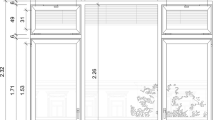Abstract
THE occupancy of air raid shelters presents, actually or potentially, many of the whole range of problems with which the practice of ventilation is concerned. The term ‘ventilation’ is here used to include heating and other air-treatment; it may be defined as ‘the provision of air hygienically and physiologically adequate in quantity and quality’. In air raid shelters conditions arise which tend to reduce the efficiency of ventilation very considerably. While on one hand, the supply of air is hampered in a number of ways by safety requirements, the demand tends at the same time to be greatly increased. Structural alterations to places used as air raid shelters usually require the blocking or baffling of the natural airways; lighting restrictions interfere further with ventilating arrangements; the danger of gas attack may reduce the available air supply merely to the air capacity of the shelter. The fitting of ventilating appliances may entail some structural weakening of a refuge; and the dependence of most large plants on outside power is also a potential source of weakness. Furthermore, since in shelters the ordinary density of living-room occupancy is much exceeded, satisfactory standards of ventilation are distinctly more difficult of attainment.
This is a preview of subscription content, access via your institution
Access options
Subscribe to this journal
Receive 51 print issues and online access
$199.00 per year
only $3.90 per issue
Buy this article
- Purchase on Springer Link
- Instant access to full article PDF
Prices may be subject to local taxes which are calculated during checkout
Similar content being viewed by others
References
Report of the Health of Munition Workers' Committee (H.M. Stationery Office, Cmd. 9065).
Houghton, F. C., Teague, W. W., and Miller, W. E., J. Amer. Soc. Heat. Vent. Engrs., 32, 315, 473 (1926).
Yaglou, C. P., J. Indust. Hyg., 9, 297 (1927).
Modern Principles of Ventilation and Heating. (London: H. K. Lewis and Co. 1937).
Bedford, T., "The Warmth Factor in Comfort at Work". Indust. Health Res. Bd. Rept. No. 76. (H. M. Stationery Office, 1936).
Report on Occupancy Tests of Air Raid Shelters for Factory Workers. (London: H. K. Lewis and Co. 1939).
Bedford, T., and Warner, C. G., J. Hyg., 39, 498 (1939).
Yaglou, C. P., Riley, E. C., and Coggins, D. I., Heating, Piping and Air Condit., 7, 65 (1936).
"Principles of Heating and Ventilation". (London: Ed. Arnold and Co., 1934).
New York Commission on Principles and Practices of School Ventilation. (Columbia University, New York, 1931).
Twort, C. C., Baker, A. H., Finn, S. R., and Powell, E. O., J. Hyg., 40, 253 (1940).
Air Raid Precautions Mem. No. 10. Provision of Air Raid Shelters in Basements. (H.M. Stationery Office, 1940).
Air Raid Precautions Handbook No. 5. Structural Defence. (H.M. Stationery Office, 1939).
Author information
Authors and Affiliations
Rights and permissions
About this article
Cite this article
WEINER, J. Ventilation of Air Raid Shelters. Nature 146, 733–737 (1940). https://doi.org/10.1038/146733a0
Issue Date:
DOI: https://doi.org/10.1038/146733a0
Comments
By submitting a comment you agree to abide by our Terms and Community Guidelines. If you find something abusive or that does not comply with our terms or guidelines please flag it as inappropriate.



